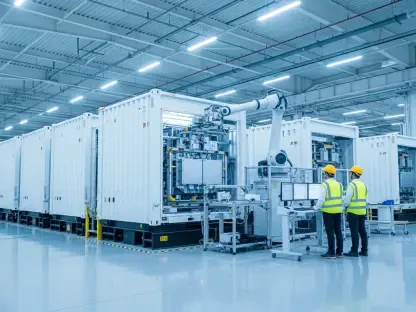The integration of Long Duration Electricity Storage (LDES) technologies presents a multifaceted challenge for energy regulators, particularly for the UK’s Office of Gas and Electricity Markets (Ofgem). This involves balancing the interests of consumers, energy producers, and storage owners while maintaining market stability and addressing socioeconomic concerns. At the center of this complex regulatory landscape is the cap-and-floor mechanism—an innovative policy aimed at managing financial interactions and ensuring fair market dynamics. As LDES becomes increasingly crucial for energy market integration, how can Ofgem navigate the interplay of conflicting interests to achieve optimal outcomes?
Understanding the Cap-and-Floor Mechanism
The cap-and-floor mechanism devised by Ofgem serves as a regulatory tool that defines a revenue range for long-duration storage projects. This range, established between a set cap and floor, intends to offer financial stability for LDES owners while safeguarding consumers from excessive energy prices. Understanding this mechanism requires delving into its components and the pivotal role it plays in mediating interests across the energy spectrum. By setting a floor, Ofgem assures storage owners of a minimum income level, thereby incentivizing investments in new technologies. Conversely, the cap ensures that excessive profits from unexpected market circumstances revert back to consumers, maintaining an affordable energy supply. This necessity arises from the evolving energy landscape, where intermittent renewable generation underscores the need for sufficient storage capacity to smooth out supply and demand fluctuations.
Additionally, the cap-and-floor mechanism mitigates risks associated with volatile electricity markets. As LDES projects contribute to grid stability by storing surplus energy during periods of high supply and discharging it when demand peaks, they reshape traditional supply and demand curves. However, challenges emerge in estimating appropriate cap and floor levels, balancing between incentivizing storage development and preventing market distortions. This regulatory framework must accurately reflect market conditions and technological advancements to appeal to investors while protecting consumer interests. The implications of misaligned caps or floors could hinder LDES deployment, impacting future grid resilience and decarbonization efforts. Thus, Ofgem’s role in continuously evaluating and adjusting these parameters is vital to successful policy execution.
Balancing Consumer and Producer Interests
The interests of consumers and producers often appear diametrically opposed within the framework of long-duration storage. Consumers naturally desire lower energy prices, enhanced service reliability, and reduced exposure to price volatility. The cap-and-floor mechanism promises to deliver these benefits by ensuring revenue surpluses benefit consumers. However, producers face conflicting priorities as LDES deployment could potentially diminish their market standing, reducing peak price scenarios crucial for their profitability. For traditional energy producers, particularly those relying on fossil fuels or established methods like Combined Cycle Gas Turbines (CCGTs), the introduction of LDES complicates existing market dynamics. As storage smooths demand peaks, it could lead to suppressed energy prices during high-demand periods, impacting profit margins for traditional generators. This aspect becomes increasingly relevant as producers confront a transitioning market that increasingly favors renewable sources and storage solutions.
By refining the cap-and-floor mechanism, Ofgem can navigate these conflicting interests. Potential refinements include dynamic adjustment protocols responsive to real-time market data, ensuring both consumer protection and fair returns for producers. Furthermore, stakeholder consultation becomes vital in aligning these interests, incorporating feedback from a diverse array of market participants to achieve consensus-driven policy. This approach enhances transparency and credibility, convincing both consumers and producers of the mechanism’s efficacy. Ensuring robust dialogue and incorporating diverse perspectives allows Ofgem to identify potential points of friction early and adjust the regulatory framework to anticipate and mitigate adverse impacts. This careful balancing act is essential for maintaining trust and cooperation among stakeholders, paving the way for seamless integration of LDES in modern energy networks.
Addressing the Impact on LDES Owners
As the market evolves with increased LDES deployment, storage owners face unique challenges and opportunities that require careful consideration. The introduction of innovative storage technologies often results in revenue cannibalization for existing facilities as new competitors enter the market. As more projects join the fray, arbitrage opportunities—capturing value from price differentials—become more limited. Consequently, existing storage owners risk diminished returns, necessitating recalibration of their business models to remain viable. Ofgem’s regulatory approach aims to buffer these impacts by staggering new entrants and ensuring that floor payments do not disproportionately skew market dynamics. These measures help prevent oversaturation and maintain sustainable growth trajectories for both new and existing storage investments. By managing entry points strategically, Ofgem can foster a competitive yet balanced marketplace, preserving the attractiveness of LDES projects through calculated market interventions.
In crafting policies that mitigate impacts on storage owners, financial risk assessments and incentive alignments become crucial components. Robust modeling provides insights into anticipated market scenarios, aiding developers in navigating uncertain financial landscapes. The success of Ofgem’s strategy relies on creating an environment where storage remains a compelling investment prospect, aligning incentives to foster innovation and competition. Technological advancements in storage efficiency, capacity, and cost-effectiveness enhance market resilience, positioning storage owners to reap long-term benefits. By addressing potential downsides, such as compressed revenue streams, through judicious policy design, Ofgem safeguards both market entry for new technologies and the continued relevance of incumbent players. Engaging with industry experts and leveraging technological insights further empowers Ofgem to devise policies that dovetail with the evolving energy landscape.
Future Considerations and Strategic Approaches
As LDES technologies penetrate further into the energy sector, Ofgem faces ongoing challenges in balancing stakeholder priorities. Future deliberations will necessitate agile policymaking that can adapt to the rapid technological advancements and shifting market dynamics characteristic of the evolving energy landscape. To achieve this, the focus expands beyond mere price regulation, encompassing sustainability, system flexibility, and innovative financial models that incentivize long-term investment. Enhancing sustainability remains a pivotal goal, with LDES playing a critical role in decarbonizing energy systems. By smoothing out supply-demand discrepancies and facilitating renewable integration, storage technologies contribute to meeting climate goals and reducing reliance on fossil fuels. Therefore, Ofgem’s policies must reflect the urgency of environmental imperatives while balancing short-term economic considerations. Strategic approaches that embrace a holistic view of energy systems integrate environmental, economic, and social dimensions, aligning stakeholder objectives across the spectrum.
Looking ahead, engaging with international partners and adopting best practices enhances Ofgem’s capacity to craft effective strategies. Collaboration with global counterparts presents opportunities to leverage extensive knowledge bases, capitalizing on shared experiences to refine cap-and-floor mechanisms. Comparative analysis with international regulatory frameworks enables the identification of successful policies, informing modifications to existing strategies. Ofgem’s active participation in global dialogues fosters a comprehensive understanding of emerging trends, positioning it as a leader in energy regulation. Furthermore, integrating cutting-edge modeling techniques and digital tools empowers Ofgem to anticipate future market developments accurately. Utilizing data analytics, AI, and machine learning within the regulatory process allows for real-time adjustments, streamlining policy execution. By remaining at the forefront of technological innovation, Ofgem ensures resilience against unanticipated challenges, reinforcing its commitment to fostering a robust and adaptable energy market.
Navigating a Complex Landscape
The integration of Long Duration Electricity Storage (LDES) technologies poses a complex challenge for energy regulators, notably for the UK’s Office of Gas and Electricity Markets (Ofgem). This task requires a delicate balancing act involving the interests of consumers, energy producers, and storage facility owners, all while maintaining market stability and addressing economic and social concerns. Central to this intricate regulatory environment is the cap-and-floor mechanism, an innovative approach designed to manage financial relationships and ensure fair market dynamics. LDES technologies are rapidly becoming vital for energy market integration due to their ability to store renewable energy over extended periods, smoothing out supply and demand fluctuations. This transition is crucial for the stability and sustainability of modern energy systems. However, it presents Ofgem with the difficult task of navigating through conflicting interests and pressures. They must find a path that optimizes outcomes without compromising any stakeholder group. How will Ofgem handle the economic, technical, and regulatory aspects to support LDES as a cornerstone of future energy strategies? The answer lies in careful policy crafting and stakeholder engagement, ensuring that all voices are heard in the evolving energy landscape.









